Data Integration Application
Data integration applications are essential tools in today's data-driven world, enabling seamless merging of information from various sources into a unified view. These applications facilitate efficient data management, enhance decision-making processes, and support business intelligence initiatives by ensuring consistent, accurate, and timely data. In this article, we explore the key features, benefits, and best practices for implementing data integration applications.
Introduction to Data Integration Applications
Data integration applications play a crucial role in modern business environments, enabling seamless connectivity between disparate systems and data sources. These applications help organizations consolidate data from various platforms, ensuring consistency and accuracy across the board.
- Improved data accuracy and consistency
- Enhanced decision-making capabilities
- Streamlined business processes
- Reduced manual data entry and errors
One of the notable services in this domain is ApiX-Drive, which simplifies the setup of integrations between different applications. By using ApiX-Drive, businesses can automate data flows, reduce the need for manual intervention, and ensure real-time data synchronization. This not only saves time but also enhances operational efficiency, making it an invaluable tool for data-driven enterprises.
Benefits and Uses of Data Integration Applications

Data integration applications provide numerous benefits by streamlining the process of combining data from various sources into a unified view. This enhances data consistency, reduces redundancy, and ensures that decision-makers have access to accurate and up-to-date information. By automating data workflows, these applications save time and resources, allowing businesses to focus on core activities rather than manual data handling. Additionally, they improve data quality and reliability, which is crucial for analytics and reporting purposes.
These applications are widely used across industries for various purposes, such as customer relationship management (CRM), business intelligence (BI), and supply chain management. For instance, services like ApiX-Drive facilitate seamless integration between different systems and applications without requiring extensive technical expertise. ApiX-Drive allows users to set up integrations quickly and efficiently, ensuring that data flows smoothly between platforms. This enables businesses to adapt to changing needs and scale their operations with ease, ultimately driving growth and innovation.
Key Features of Data Integration Applications

Data integration applications are essential tools for organizations looking to consolidate data from various sources into a unified view. These applications streamline data management processes, ensuring consistency and accuracy across different platforms.
- Data Connectivity: Seamlessly connect to a wide range of data sources, including databases, cloud services, and on-premises systems.
- Data Transformation: Transform data into the required format through cleansing, mapping, and enrichment processes.
- Real-Time Integration: Enable real-time data integration to ensure up-to-date information is always available.
- Scalability: Handle large volumes of data efficiently, scaling as your data needs grow.
- Security: Ensure data security and compliance with robust encryption and access control mechanisms.
- Automation: Automate repetitive tasks to save time and reduce the risk of human error.
- Monitoring and Reporting: Provide detailed monitoring and reporting tools to track integration performance and identify issues.
One notable service that simplifies data integration is ApiX-Drive. It offers user-friendly tools to set up integrations without any coding skills, making it accessible for businesses of all sizes. By leveraging such services, organizations can achieve seamless data integration, enhancing their decision-making processes and operational efficiency.
Challenges and Best Practices in Data Integration

Data integration poses several challenges, including data quality issues, disparate data sources, and the complexity of data transformations. Ensuring that data is accurate, consistent, and timely is crucial for making informed business decisions. Moreover, integrating data from various sources, such as databases, cloud services, and third-party applications, requires careful planning and execution.
One of the primary challenges is maintaining data quality and consistency across different systems. Another significant issue is the complexity involved in transforming and mapping data from heterogeneous sources into a unified format. Additionally, real-time data integration can be resource-intensive and requires robust infrastructure.
- Ensure data quality by implementing validation and cleansing processes.
- Utilize data integration tools like ApiX-Drive to simplify and automate data workflows.
- Establish clear data governance policies to maintain data integrity.
- Invest in scalable infrastructure to handle real-time data integration.
By addressing these challenges and adopting best practices, organizations can achieve seamless data integration. Tools like ApiX-Drive offer valuable features for automating data workflows, reducing manual efforts, and ensuring data consistency. Ultimately, a well-executed data integration strategy can significantly enhance business intelligence and operational efficiency.
Conclusion and Future Outlook of Data Integration Applications
Data integration applications have become essential tools for businesses seeking to unify disparate data sources, streamline operations, and gain comprehensive insights. The continuous evolution of these applications is driven by the increasing complexity and volume of data, necessitating more advanced and scalable solutions. As organizations continue to adopt cloud technologies and big data analytics, the demand for seamless data integration will only grow, pushing the boundaries of what these applications can achieve.
Looking ahead, the future of data integration applications lies in the adoption of AI and machine learning to automate and optimize integration processes. Tools like ApiX-Drive are at the forefront, offering user-friendly interfaces and powerful functionalities to facilitate seamless data connections across various platforms. As these technologies evolve, we can expect more intelligent, self-configuring systems that reduce manual intervention and enhance data accuracy and consistency, ultimately driving more informed decision-making and operational efficiency.
FAQ
What is Data Integration?
Why is Data Integration important for businesses?
How can I automate Data Integration processes?
What are the common challenges in Data Integration?
How can I ensure the security of integrated data?
Time is the most valuable resource in today's business realities. By eliminating the routine from work processes, you will get more opportunities to implement the most daring plans and ideas. Choose – you can continue to waste time, money and nerves on inefficient solutions, or you can use ApiX-Drive, automating work processes and achieving results with minimal investment of money, effort and human resources.

